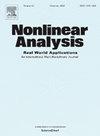Stability and Hopf Bifurcation for a delayed hand–foot–mouth disease model with continuous age-structure in the exposed class
IF 1.8
3区 数学
Q1 MATHEMATICS, APPLIED
引用次数: 0
Abstract
Hand–foot–mouth disease (HFMD) is a mild and highly contagious viral infectious disease common in young children, but anyone can get it. In order to reveal the transmission phenomena of HFMD, we formulate a HFMD model with age structure for latently infected individuals and atime delay. The time delay occurs during the transition from latent to infectious individuals. We reformulate the model as an abstract Cauchy problem and show the presence of equilibria. We specify the basic reproduction number which determines the threshold dynamics of the HFMD model. For , the disease-free equilibrium is globally asymptotically stable. For , we derive that the endemic equilibrium is unstable, which is the criteria for the occurrence of Hopf bifurcation. Finally, some numerical simulations demonstrate the obtained theoretical results and shed light on the impact of time delay on the evolution of HFMD spread.
暴露类年龄结构连续的延迟手足口病模型的稳定性和Hopf分岔
手足口病(手足口病)是一种常见于幼儿的轻度和高度传染性的病毒性传染病,但任何人都可能感染。为了揭示手足口病的传播现象,我们建立了具有潜伏感染者年龄结构和时滞的手足口病模型。时间延迟发生在从潜伏个体到感染个体的过渡期间。我们将该模型重新表述为一个抽象的柯西问题,并证明了平衡点的存在。我们指定了决定手足口病模型阈值动力学的基本再现数∑0。对于f = 0<1,无病平衡Ē0是全局渐近稳定的。在给定的条件下,得到了局部均衡Ē *是不稳定的,这是Hopf分岔发生的判据。最后,通过数值模拟验证了理论结果,揭示了时间延迟对手足口病传播演化的影响。
本文章由计算机程序翻译,如有差异,请以英文原文为准。
求助全文
约1分钟内获得全文
求助全文
来源期刊
CiteScore
3.80
自引率
5.00%
发文量
176
审稿时长
59 days
期刊介绍:
Nonlinear Analysis: Real World Applications welcomes all research articles of the highest quality with special emphasis on applying techniques of nonlinear analysis to model and to treat nonlinear phenomena with which nature confronts us. Coverage of applications includes any branch of science and technology such as solid and fluid mechanics, material science, mathematical biology and chemistry, control theory, and inverse problems.
The aim of Nonlinear Analysis: Real World Applications is to publish articles which are predominantly devoted to employing methods and techniques from analysis, including partial differential equations, functional analysis, dynamical systems and evolution equations, calculus of variations, and bifurcations theory.

 求助内容:
求助内容: 应助结果提醒方式:
应助结果提醒方式:


